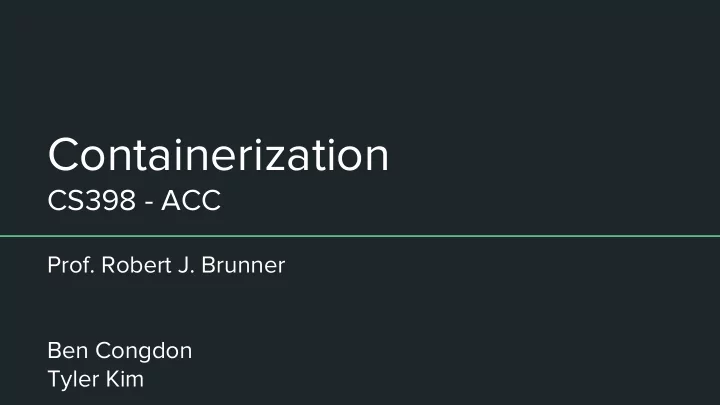

Containerization CS398 - ACC Prof. Robert J. Brunner Ben Congdon Tyler Kim
What is Containerization? ● OS-level virtualization. ● Deploy and Run distributed applications without VMs ● Isolated Environment ○ Each container can have different files, environment variables, libraries, and different OS. ○ Multiple isolated application can run on a single host and access the same OS kernel
Motivation for Containerization ● VMs are great, but have high runtime overhead ○ Can we scale faster and more easily? ● What if we could sandbox VMs, but share the OS kernel? ● Enables different software architectures and practices
Big Idea: Containers have less OS overhead Traditional VM-based Container Infrastructure Infrastructure https://newsroom.netapp.com/blogs/containers-vs-vms/
Popular Containerization Platforms
What is Docker? ● Open platform to develop , deploy , and run applications with containers. ● Abstracts hardware virtualization for containers. ● Client-Server Architecture
Docker Concepts ● Image ○ Frozen description of an environment ● Container ○ Running instantiation of an image ● Volume ○ Persistent data storage
Docker Concepts ● Dockerfile ○ Describes everything your container needs: ■ Dependencies ■ Source Code / Binaries
The Dockerfile Overview Guide to Running Code in Docker: 1. Inherit from a parent OS/platform container 2. Install any packages / libraries you need 3. Add any source code you need 4. Attach any volumes you need for data persistence 5. Set a command to be run at startup
The Dockerfile Essential Commands: ● FROM - Inherit from a parent container ○ i.e. “FROM ubuntu” ● RUN - Runs a command during the build process i.e. “RUN apt-get install python3” ○ ● ADD - Copies files from the build directory into the image ○ i.e. “ADD hello_world.py /usr” EXPOSE - Register a port that the image will listen on ● ○ i.e. “EXPOSE 80” ● CMD - Set the default command to be executed on startup ○ i.e. “CMD python /usr/hello_world.py”
The Dockerfile ● Each command in a Dockerfile creates an intermediate image ○ Useful for caching! ● Structure your Dockerfiles to take advantage of caching Install packages first, then add source code ○ ○ Within reason, “Funnel down” from most general to most specific
Where to go from here ● Docker Swarm Pools multiple Docker engines into a combined virtual host ○ ○ Allows multiple VMs to collaborate to host clustered Docker containers ● Docker Compose ○ Orchestrate multiple-container applications ○ Declarative format for configuring volumes, container networking, and scaling
MP7 - Docker ● Released Tonight. Due next Tuesday at 11:59pm (as normal) ● Wednesday: - Docker Demo - Docker MP Office Hours.
Recommend
More recommend